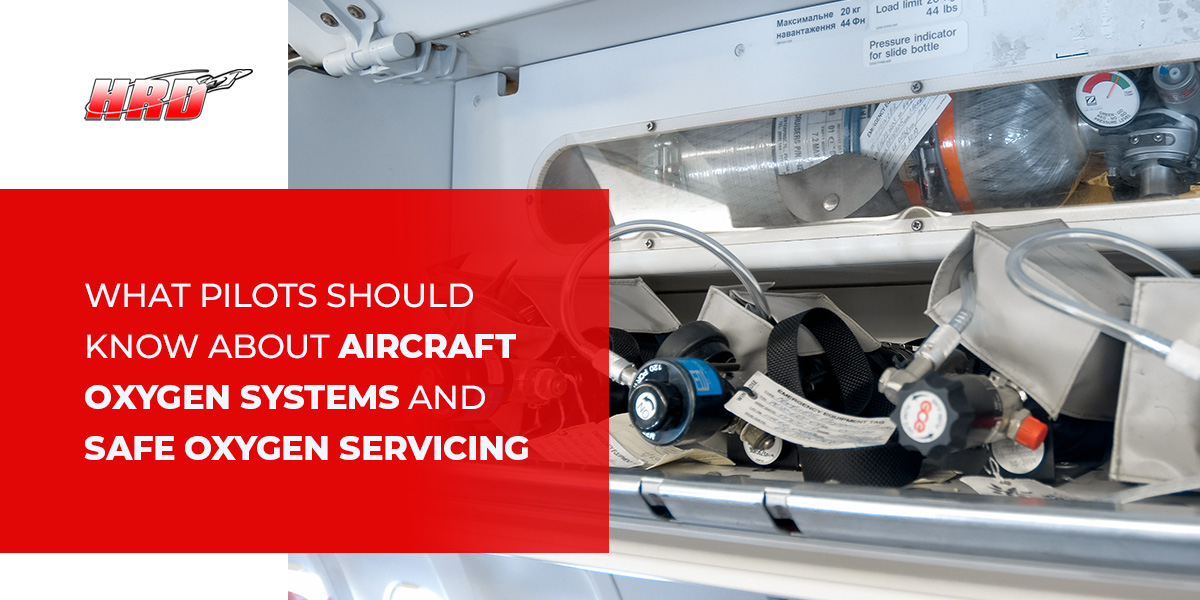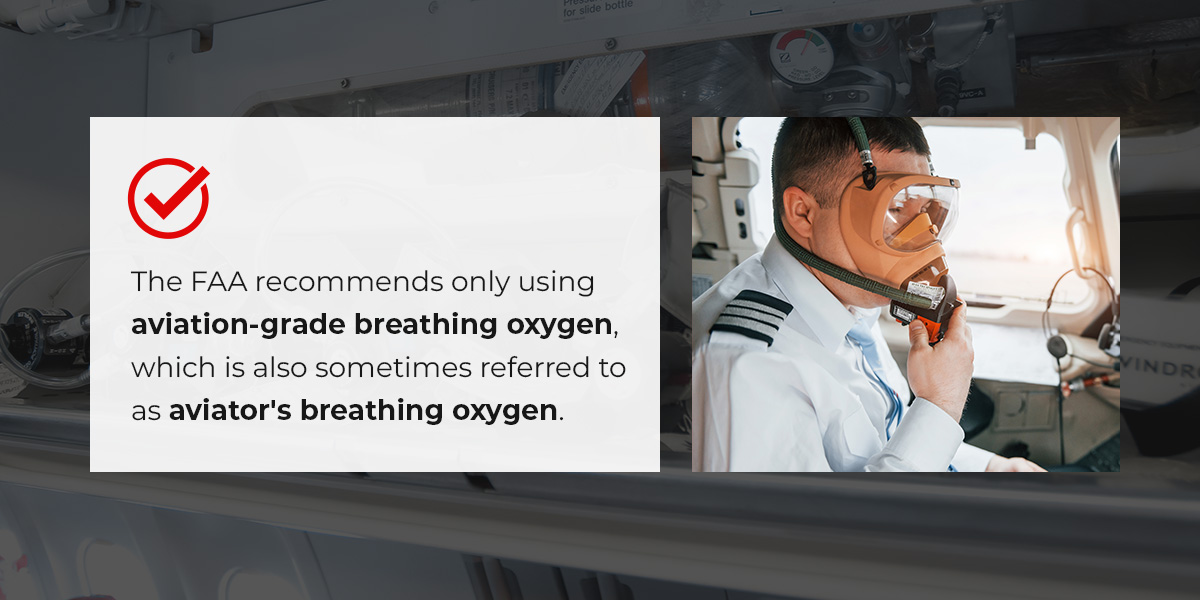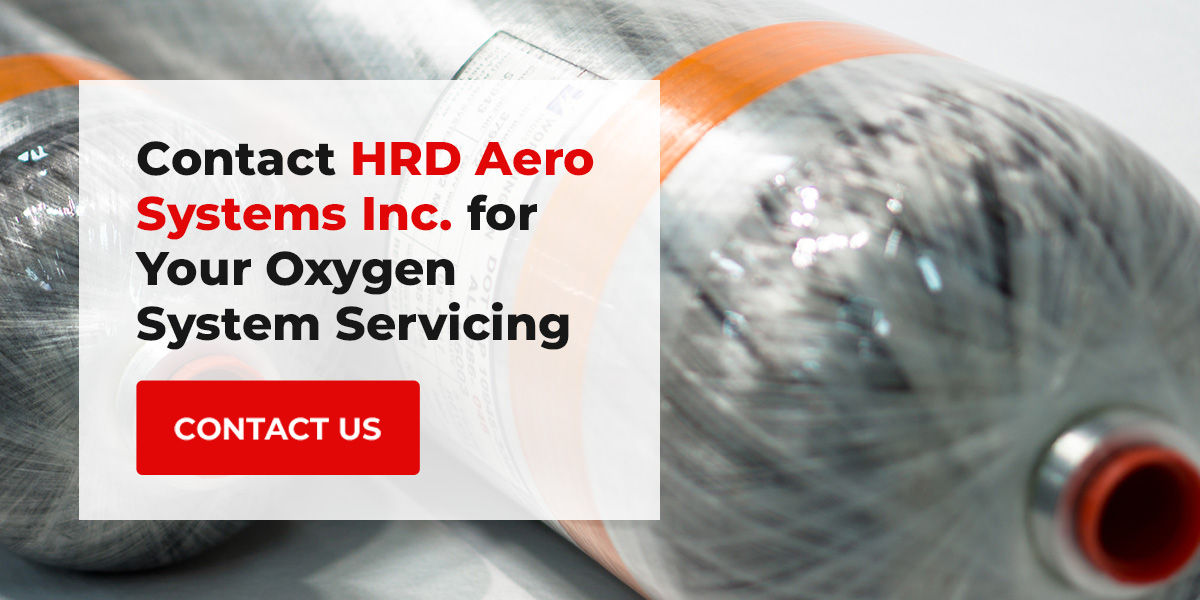As a pilot, it’s essential to have a firm awareness and comprehension of the aircraft oxygen system and proper aircraft oxygen servicing. This knowledge helps meet definitive aircraft regulatory requirements set out by bodies such as the FAA and promotes the safety of pilots and passengers.
FAA regulations outline specific parts relating to aircraft maintenance and inspections as well as other topics. Below, we examine aspects of the FAA oxygen requirements, aircraft oxygen systems, compliant and safe aircraft oxygen servicing and maintenance’s pivotal role.
Understanding Aircraft Oxygen Systems
Supplemental oxygen, fed through oxygen masks in an emergency, is essential in aviation. Administering it effectively requires a fully functional, readily accessible oxygen system.
Components of an Aircraft Oxygen System
You may use a portable or fixed oxygen system on your aircraft, depending on the size of the plane and planned use. Either way, the aircraft oxygen system has fundamental components that ensure its proper functionality, including:
- Oxygen cylinders
- Regulators
- Flow indicators
- Plumbing and delivery valves
- Oxygen masks or nasal cannula
Types of Oxygen Systems
There are two primary categories of aircraft oxygen systems — continuous flow and demand flow. The kind of system used on an aircraft depends on the aircraft type, its altitude limits and whether it has a pressurized system. The standard types of aviation oxygen systems are:
- Continuous flow systems: This system provides a steady and constant supply of oxygen typically used at under 25,000 feet mean sea level (MSL) or when using portable oxygen.
- Diluter demand systems: This particular system is used between 25,000 and 40,000 feet MSL and dilutes the oxygen by combining it with cabin air to maintain safe oxygen saturation.
- Pressure demand systems: These systems deliver pressurized oxygen only as the individual inhales and are used when flying at over 40,000 feet MSL to allow safe oxygen level absorption.
What Kind of Oxygen Is Used in Aircraft?
The FAA requirement for oxygen used in aircraft is aviation breathing oxygen, which is needed at higher altitudes and in non-pressurized cockpits.
The FAA recommends only using aviation-grade breathing oxygen, which is also sometimes referred to as aviator’s breathing oxygen. In other applications, such as fighter jets and related aircraft, pilots may require military specification oxygen.
Practicing Safe Oxygen Servicing
Safely handling and servicing aircraft oxygen systems is essential. That’s why only certified repair stations are permitted to work on aircraft to do maintenance, inspections and repairs, according to FAA Part 145 of the Code of Federal Regulations.
Oxygen Cylinder Handling and Inspection
When aircraft oxygen cylinders require handling or inspection, it’s essential to follow proper safety procedures and handling techniques to prevent damage and maintain the integrity of the oxygen cylinders.
Conduct regular visual inspections of the cylinders to assess if there’s any damage, leaks or potential expiry dates. Further, proper storage practices include keeping the cylinders upright at all times, securing them during and after moving and keeping them in ventilated areas away from flammable materials.
Oxygen Assemblies Cleaning Procedures
Oxygen and Oil do not mix! It’s critical to follow the cleaning procedures listed in the CMM’s as well as maintain the environment to the required standards. For the safety of those not only using the oxygen, but those handling the units and even the aircraft where the oxygen assembly is installed.
Additionally, safe and clean storage of oxygen assemblies is critical to avoid any contaminants from entering the system before installation, which again could cause an explosion or fire.
Oxygen Cylinder Filling Procedures
Accurate, safe cylinder filling remains a priority. It’s essential to verify the purity of aviation breathing oxygen and maintain its efficacy, which is why repair stations use oxygen analyzers and leak detection solutions during the following standard process:
- Preparing to fill the system: The repair station must confirm that the equipment and facilities meet regulatory standards before beginning work.
- Weighing and documenting: Next, they need to weigh the empty oxygen cylinders to determine how much oxygen is required, document the cylinder details and track the filling process.
- Connecting and purging: They connect the filling equipment to the oxygen source and the cylinder and begin by purging the system to ensure against residual gas or potential contaminants.
- Filling the cylinders: Now, the repair station starts the controlled filling of the cylinders with the precise amount of aviation breathing oxygen. Maintaining proper fill rates and monitoring pressure levels during this step is imperative.
- Verifying, documenting and labeling: It’s time to verify that the cylinders have the correct fill weight. Then, the repair station needs to document the process and label the system with the fill date and other pertinent data.
Fire Safety and Hazards
Whether you need to use safety equipment in an aircraft in flight or during service and maintenance, it’s essential to know what to do during an aircraft fire. Additionally, understand the measures and steps to take to prevent an aircraft fire emergency, especially where flammable and combustible materials and oxidizers such as oxygen are concerned.
Aircraft Oxygen System Maintenance and Training
Apart from standard and routine aircraft oxygen servicing, your aircraft oxygen system will require systematic maintenance to ensure reliable performance and meet regulatory requirements. In addition to keeping oxygen systems working correctly, pilots should undergo relevant training regarding the crucial elements of their life-saving aircraft oxygen system.
Regular maintenance is paramount for ensuring aircraft oxygen systems function properly. When the system undergoes maintenance or refilling, the repair station will need to perform a system purge each time the oxygen system is opened. This is to rid the system of contaminants and residual gases. The repair station must also inspect the system components for wear, damage and potential corrosion.
It’s also necessary to know aircraft safety equipment servicing requirements, as they’ll help inform you what needs service and maintenance and at what frequency. If any parts need to be maintained or replaced, the new, used or repaired part requires an 8130 certificate as proof that the component meets the required standards and is airworthy.
Contact HRD Aero Systems Inc. for Your Oxygen System Servicing
The FAA provides strict guidelines regarding regularly checking, servicing and maintaining all safety equipment, including aircraft oxygen systems, to ensure they remain airworthy and fit for use. This means you must ensure regular inspections, correct cylinder refilling and oxygen system maintenance and repairs.
HRD Aero Systems is an FAA-approved Part 145 repair station that’s fully certified by the relevant bodies, and we have received several awards that stand as beacons of our dedication to excellence and commitment to servicing the aviation industry. We specialize in aircraft equipment maintenance and repair services, including aircraft oxygen servicing.
Learn more about our offerings and how we can help keep your aircraft oxygen system FAA-compliant and in airworthy condition. Complete our contact form or call us at 877-473-2376 today.



